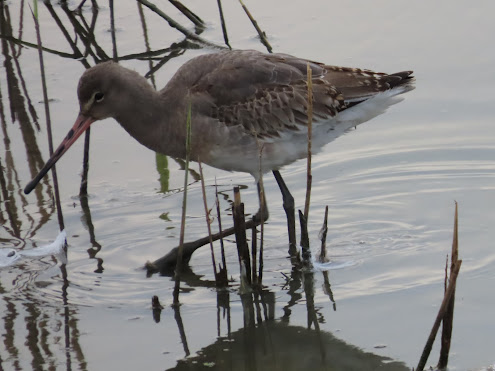With the temperatures falling, the birds are forced into migrating to warmer grounds. A case of this was by far the most interesting sighting of the day, that of a BITTERN. As I was sitting in the Public Viewpoint, just behind the dunes, one of those elusive brown herons flew over me heading in from the sea, before heading south towards Sizewell B. To get such a view of such an elusive bird migrating like this is amazing. Although a fairly easy to see bird at Minsmere, Minsmere is maybe the best site to see them in the country, for one of them to be out in the open is very rare, they usually slink around at the base of reedbeds. This is only my second ever record of a migrating bittern, the first was just earlier this year at Cley in late August.
At this time of year waterfowl dominate the scene at wetlands such as Minsmere, attracted to the large amounts of water on the reserve. As is usual there were good numbers on the Scrape and Island Mere, but the Levels had yet to flood so were still quiet. There were a few goodies, high winter specialists coming in when that little bit of colder weather falls. Best of the show were four WHOOPER SWANS on Island Mere, among the large herd of MUTES accompanied by 100 GADWALL as well. A female GOLDENEYE was on South Scrape, which although a common wintering bird on various water bodies, is actually quite rare at Minsmere, this being only my second or third record. One last good record was a count of twenty PINTAIL on East Scrape, a good total, as they are not that common at Minsmere.
Although at this time of year the Scrape can be quiet for WADERS, some low water levels on East Scrape attracted a few to linger. Around ten AVOCETS were around, a bird that though an iconic breeding bird here is quite rare in winter. Good numbers of BLACK TAILED GODWIT were present, as they seem to be at all times of the year, and there were also ten DUNLIN and seven GOLDEN PLOVER hanging out with the many LAPWING.
A range of extras was provided by the smaller birds, our little songsters that have turned quiet for the shorter months. Seven STONECHATs were around, two at the beginning of North Wall and five in the Dunes, as usual perched on the top of a bush, a bird which gives good views. As they say, where there's stonechats there are also DARTFORD WARBLERS, and there was one of those resident warblers in a gorse bush with a pair of stonechat, behind the Public Viewpoint. Further along, seven SISKIN were feeding in alders between South and West Hide their meloncholic "sighing" call carrying over the marshes. And finally at several places around the reserve the metallic "pinging" of BEARDED TITS could be heard over the reedbeds, although they didn't appear above the fronds.
As you would expect from the greatest bird reserve in the country there was another good showing of mid winter birds today. Its quite a relief to finally see nature responding to the turning of winter, I thought at some point the leaves would never fall, and we would be in some weird non-season. Its still early days, but the evidence is in that climate change is upon us, although its fairly tame at the moment, but nature is struggling to keep up. Only time will tell the full effects of this will be, but it doesn't bode well. We all know what to do to mitigate it, its just whether we can be bothered.






No comments:
Post a Comment